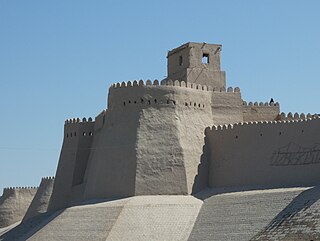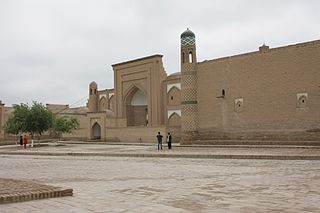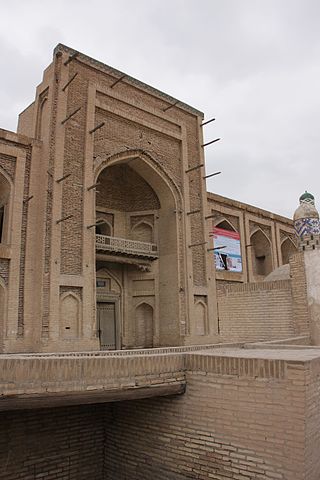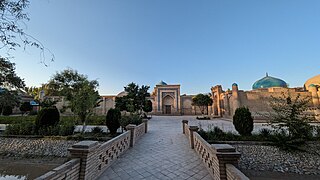
Khiva is a district-level city of approximately 93,000 people in Khorazm Region, Uzbekistan. According to archaeological data, the city was established around 1500 years ago. It is the former capital of Khwarezmia, the Khanate of Khiva, and the Khorezm People's Soviet Republic. Itchan Kala in Khiva was the first site in Uzbekistan to be inscribed on the World Heritage List (1991). The astronomer, historian and polymath, Al-Biruni was born in either Khiva or the nearby city of Kath.

Itchan Kala is the walled inner town of the city of Khiva, Uzbekistan. Since 1990, it has been protected as a World Heritage Site.

Konya Ark is the citadel in the Itchan Kala, the historic old town of Khiva in Uzbekistan. It is an outstanding part of the UNESCO World Heritage Site.
The Pahlavon Mahmud complex, Pahlavon Mahmud mausoleum or Polvon ota mausoleum is a memorial monument in Khiva, Khorezm. The mausoleum complex has a total area of 50x30m, and was originally built in 1664 as a miraculous dome over the grave of Pahlavon Mahmud. Pahlavon Mahmud (1247-1326) was a local poet who emerged from humble craftsmen, and was also famous for his heroic strength as an unbeatable wrestler, and his ability to heal people. His tomb has been and is still considered a sacred place by representatives of Uzbeks, Turkmens, Karakalpaks and other peoples. This complex is also known in Khiva as “Hazrati Pahlavon Pir”.

The Polvon Gate is the eastern gate of the Itchan Kala fortress in Khiva (1806). The people also call it Poshshob (Jallod) Gate or Slave Gate. This gate is the main entrance to Khiva, Uzbekistan, and it was built by seven craftsmen under the supervision of a master builder. A canal that brought water from the Amu Darya river surrounded the fortress wall. The gate had a bridge that could be lifted at night. Polvon Gate's master builder received the same salary as the master builder who worked at the Ark Gate, the gate of the Khiva Khan's palace. The current appearance of Polvon Gate is the result of several renovations. Previously, the gate protruded slightly outward from the fortress wall. It had a watchtower on top that allowed to observe the outside of the city. The gate was rebuilt in 1806 by Eltuzarkhan from baked bricks. In addition, a long corridor – a vault was also built, which served as a place for trade stalls. The towers on the side of the gate were connected to the city wall. After the construction of the caravanserai and the covered bazaar in 1832–1833, the gate lost its role as a market. In 1835, the Olloqulixon Madrasa was built inside the gate, and its western part was rebuilt. A new bathhouse with two domes and a portal was built in front of it. The inner courtyard was enlarged as a result of the construction of the Olloqulikhan madrasah. It was also called the “Flower Gate” because of its beautiful glazed tiles. The gate was named after the Khiva poet, who lived in the seventh century, the author of more than three hundred quatrains, and the defender of the city, Pahlavon Mahmud. Pahlavon Mahmud was buried in a beloved tomb behind the Juma Mosque.

Arab Muhammadhan Madrasah is an architectural monument in Khiva as a part of Itchan Kala, Khorazm Region. Today, the monument is located at 27 Zargarlar Street, Itchan-Kala neighborhood.
Matniyoz Devonbegi Madrasah is an architectural monument in the city of Khiva, Khorazm Region. The madrasah was built in 1871, and today it is located at 19, Pahlavon Mahmud Street, "Itchan Kala" neighborhood of Khiva. The historical object "Itchan Kala" state museum-reserve belongs to the state property based on the right of operational management.

Muhammad Aminkhan Madrasah is an architectural monument in Khiva (1852-1855). Built by Muhammad Amin Khan. The Madrasah is located in the western part of the Itchan Kala. It was built in 1852–1855 with the funds and decree of the Uzbek ruler Muhammad Aminkhan. Muhammad Aminkhan Madrasah is the largest and most tiled in comparison to other Khiva madrasahs.
Abdullakhan Madrasah is an architectural monument in Khiva. It is located between Olloquli Khan and Kutlugmurad Inak madrasas in Itchan Kala. It was built in memory of Abdulla Khan by his mother after his death at age 17 in 1855 in a battle with Turkmen Yavmuts. It is located west of the White Mosque.

Abdurasulboy Madrasah is a former madrasa in Khiva, Uzbekistan. It was built according to the order of Mirzabashi Abdurasulboy in 1906. In 1990, it was included in the list of UNESCO World Heritage Sites as a part of Itchan Kala. Currently, it is used as a sozana embroidery workshop and exhibition space.

Khojash Mahram Madrasah is an architectural monument in the city of Khiva, Khorazm Region of the Republic of Uzbekistan. The madrasah was built in 1839 by Khojash Mahram. Today, the madrasah is located at 11, Pahlavon Mahmud street, Itchan Kala, next to the Pahlavon Mahmud complex.

Khojamberdibi Madrasah is an architectural monument in the city of Khiva, Khorazm Region of the Republic of Uzbekistan. The monument, was originally built in 1688; it was rebuilt in 1834 and got its present appearance. Today, the madrasah is located at 22, Zargarlar street, Itchan Kala neighborhood.
Khorezmshakhs' Madrasah is a cultural heritage object in Uzbekistan. The madrasa was built in 1915. It is located at 51 Mevaston Street, Mevaston neighborhood, Khiva, Khorazm Region. According to the decision of the Cabinet of Ministers of the Republic of Uzbekistan No. 100 dated February 24, 2021 on additional measures for the development of domestic and pilgrimage tourism, the Khorezmshakhs Madrasah was included in the priority restoration program of cultural heritage objects used in tourism routes in 2021–2025. The madrasah is in the possession of the Department of Cultural Heritage of Khorezm region.
Talib Makhsum Madrasah is an architectural monument in Khiva, Khorazm Region, Republic of Uzbekistan. The madrasa was built in 1910 at the expense of Talib Makhsum (Makhdum), a member of khan family of Khiva Khanate. Today, the monument is located at 22, Islam Khoja Street, "Itchan Kala" neighborhood.

Amir Tora madrasah is a cultural heritage object located in the historical center of Khiva region in Uzbekistan. It was taken under state protection as an architectural monument. It is located in the northern part of the Itchan Kala.

Said Mahruyjan Complex is an architectural monument in the Khiva city, Khorazm Region of the Republic of Uzbekistan. The complex consists of a madrasa, a monastery, etc. built in 1884 around the tomb of Said Muhammad Mahruyjan. Today it is located at 84, Amir Temur Street, "Mevaston" neighborhood.

Islamkhodja Madrasah is an architectural monument in Khiva. It is located in the center of the Itchan Kala. It was built by Islam Khodja,the prime minister and father-in-law of Khiva-Isfandiyar Khan(1908-1910).

Kazi Kalyan madrasah - an architectural monument in Khiva (1905); The madrasah is part of the Itchan Kala. The Kazi Kalyan Madrasah is part of the monuments of the Itchan Kala Museum-Reserve. The structure is located between Juma Mosque (Khiva) and Matniyoz Devonbegi Madrasah. It was built in 1905 by the chief judge of Khorezm, Mohammad Salih Okhund.
Musa Tora Madrasah is an architectural monument in the city of Khiva, Khorazm Region of the Republic of Uzbekistan. Today, the madrasa is located at 8, Boyochchilar Street, "Itchan Kala" neighborhood, in the central part of Itchan Kala. The monument was built in 1841 at the expense of funds of the Musa Tora, the grandson of Olloquli Khan,.
The Mozori Sharif Madrasa is an architectural monument in Khiva city of Khorezm region of the Republic of Uzbekistan. Currently, the madrasa is located in the Pahlavon Mahmud street, house 20. It was built in 1882 by the order of Muhammad Rahim Khan II (Feruz) and the funds of his son Toshhovuz ruler - Iso to’ra by the master Qalandar Kochim.


















